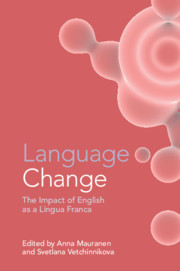Book contents
- Language Change
- Language Change
- Copyright page
- Contents
- Figures
- Tables
- Contributors
- Acknowledgements
- Abbreviations
- Introduction
- Part I Pooling Perspectives
- 1 Calling Englishes As Complex Dynamic Systems: Diffusion and Restructuring
- 2 English as a Lingua Franca in the Context of a Sociolinguistic Typology of Contact Languages
- 3 How Writing Changes Language
- 4 ELF and Translation As Language Contact
- 5 Present-Day Standard English
- 6 Beyond Language Change
- Part II Zooming in on ELF
- Index
- References
4 - ELF and Translation As Language Contact
from Part I - Pooling Perspectives
Published online by Cambridge University Press: 17 December 2020
- Language Change
- Language Change
- Copyright page
- Contents
- Figures
- Tables
- Contributors
- Acknowledgements
- Abbreviations
- Introduction
- Part I Pooling Perspectives
- 1 Calling Englishes As Complex Dynamic Systems: Diffusion and Restructuring
- 2 English as a Lingua Franca in the Context of a Sociolinguistic Typology of Contact Languages
- 3 How Writing Changes Language
- 4 ELF and Translation As Language Contact
- 5 Present-Day Standard English
- 6 Beyond Language Change
- Part II Zooming in on ELF
- Index
- References
Summary
This paper explores multilingual language contact in seemingly unrelated settings: translation and English as a lingua franca, also touching on learner language. By delving into similar processes in these settings at three levels – the macro level of a language as a whole, the intermediate level of social interaction and the micro level of cognition – it argues that translation and ELF are sites of multilingual contact resulting in a degree of hybridization in the languages involved, and are thereby important drivers of language change. It is suggested that macro-level similarities in translation and ELF, such as the relative over-representation of high-frequency items and structures and untypical multiword combinations, ensue from interactional and cognitive processes where one fundamental mechanism is priming. Translations engage in cross-linguistic textual priming, while users of ELF interact with other ‘similects’ in complex second-order language contact. Both can contribute crucially to understanding processes of change and contact-induced variation.
Keywords
- Type
- Chapter
- Information
- Language ChangeThe Impact of English as a Lingua Franca, pp. 95 - 122Publisher: Cambridge University PressPrint publication year: 2020
References
References
Corpora
- 2
- Cited by

